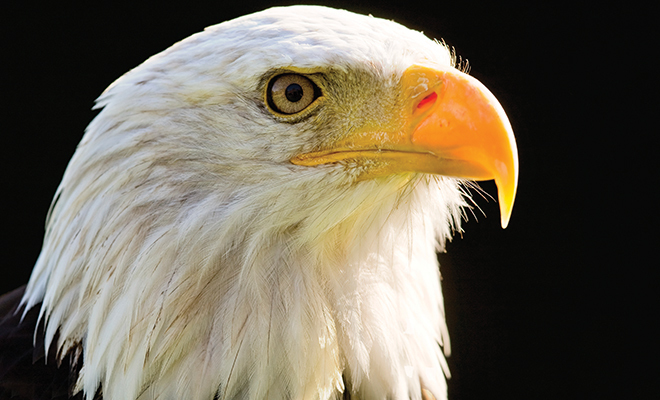
The Majestic Birds of Prey
“Once you stare into the eyes of one of these beings, you can’t help but want to learn more and help in their survival,” Cummings emphasizes. “Educational programs give us the platform we need to introduce simple tips that actually make a difference in the lives of all wild creatures.”
Spirit, a magnificent Bald Eagle with a bright white head and tail feathers, takes flight and circles Jordan-Hare Stadium before kickoff at Auburn University football games. Spirit was discovered in 1995 as an injured fledgling in Florida; he came to the Southeastern Raptor Center at Auburn’s College of Veterinary Medicine in 1998 and joined the educational collection at the center. Spirit is non-releasable due to his damaged beak.
Spirit and Nova, a Golden Eagle that also soars to inspire fans, are raptors, or birds of prey, a broad category of bird that primarily hunts other animals or scavenges for carrion. The term raptor is derived from the Latin word rapere, meaning “to seize,” and includes diurnal birds, or those that are chiefly active in the daytime, as well as nocturnal owls. Raptors are distinguished by strong grasping feet with sharp talons used to seize prey, a hooked beak used to consume prey and a diet mostly of other animals.
Most raptors are members of the orders Strigiformes (owls) or Falconiformes (falcons, hawks, eagles, osprey, harriers and kites). They typically are at the top of the food chain in their ecosystems, which makes them ideal indicators of the health of their environment. They prey on a variety of other animals, including birds, mammals, insects, amphibians and reptiles. All raptors are protected by state and federal laws, and wildlife rehabilitation centers are required to have a permit from the United States Fish and Wildlife Service and the requisite state permit. It is illegal to keep a native raptor as a pet, says Gail Laux of the Ohio Bird Sanctuary in Mansfield, Ohio.
“Birds of prey connect us to an ancient wisdom. Their soulful gaze and strong instinct have carried their own kind throughout history,” asserts Christine Cummings, president of A Place Called Hope, Inc., a non-profit rescue and education center in Killingworth, Connecticut.
“Survival in the wild is not easy,” Cummings continues. “Ninety-eight percent of the birds we rescue have encountered some sort of conflict with human beings. From habitat destruction, vehicle strikes, window collisions, cat or dog attacks, garbage entanglement, secondary poisoning and pesticide ingestion, it’s a wonder any survive at all. The odds are truly against them. That’s why we feel a need to intervene.”
In the past, “let nature take its course” was the rule of thumb, according to Cummings. Today, we owe it to our wildlife to get involved and try to lessen the everyday conflicts our native wildlife may be facing in our own backyards. Rescue and education centers such as A Place Called Hope, the Ohio Bird Sanctuary and the Southeastern Raptor Center offer live bird experiences as a way to help people make a personal connection to a bird of prey. “Once you stare into the eyes of one of these beings, you can’t help but want to learn more and help in their survival,” Cummings emphasizes. “Educational programs give us the platform we need to introduce simple tips that actually make a difference in the lives of all wild creatures.” Using window decals to break up reflection or eliminating the purchase of canned beverages packaged with plastic holders are small actions individuals can take that make a positive difference in the lives of wildlife.
“Birds of prey are predators, and even the smaller species sport weapons on their feet. They are dangerous to handle unless you are experienced and understand their defense mechanisms,” Cummings notes. Each state’s licensed wildlife rehabilitators are trained to safely work with the animals they specialize in. “It’s always a good idea to find your local rehabilitators prior to an animal crisis; having an available phone number can save valuable time when faced with an animal that might be suffering. Most rehabilitators network and can quickly direct you to the right person.”
If you encounter an injured bird of prey and have managed to contain it, it’s imperative to get immediate help. Bones that are fractured must be set within the first 24 to 36 hours to successfully result in releasability. Do not offer food or water. “Humans nature gives us an uncontrollable urge to feed or water a suffering being. In the case of wildlife, that food or water may actually kill them,” Cummings warns. She recommends placing a laundry basket or box over the bird until a professional arrives. “Be mindful of the taloned feet. It’s not the beak you need to be concerned with. The crushing power and defense ability all lies within the legs and feet. Beaks are their knife and fork, too valuable to use in defense and not worth the risk of injury.”
“The Southeastern Raptor Center brought two rehabilitated hawks and an owl to Camp ASCCA last summer and we watched the release,” beams Reagan Bush, a frequent camper at the Easter Seals facility near Auburn University. “It was a huge thrill to watch them fly back into their natural habitat!” With vigilance, we can all help preserve wildlife for the future.
Sources: aplacecalledhoperaptors.com, calmzoo.org, ohiobirdsanctuary.com, raptorresearchfoundation.org, vetmed.auburn.edu, worldbirdsanctuary.org.







